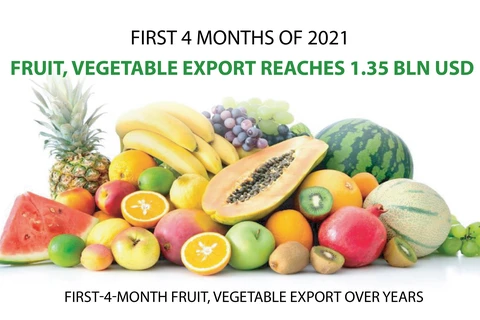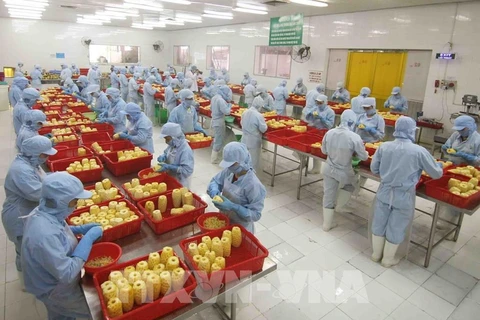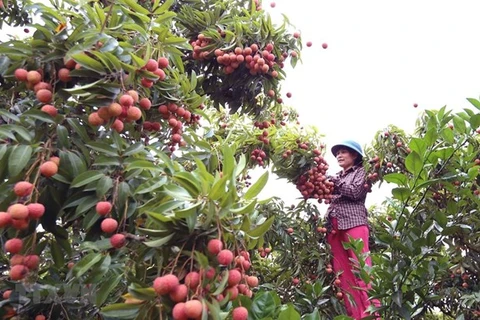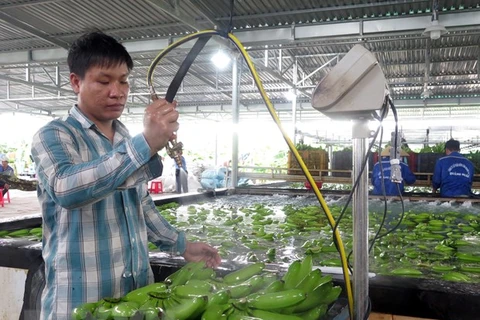Hanoi (VNS/VNA) - Vietnam will have many more opportunities to export fruit and vegetables to potential markets in 2022, providing local producers meet international standards on quality and management of growing regions, according to the Ministry of Agriculture and Rural Development (MARD).
It is expected that next year China will issue permits allowing the import of passion fruit from Vietnam, said Le Van Thiet, deputy director of MARD’s Plant Protection Department. If it weren't for the COVID-19 pandemic, China would have inspected the sweet potato and durian growing areas too.
Due to the pandemic, it is thought that it will not be until next year that Chinese authorities will inspect Vietnamese passion fruit, sweet potato and durian.
Vietnam currently exports ten different kinds of fruit, under official quotas, to China.
Authorities have also asked Japan to provide export licenses for Vietnamese fresh longan from 2022.
According to the Vietnam Trade Office in Japan, the country mainly imports dried or frozen longan products for processing tea and beverage products.
If Vietnam is issued with an import license for Japan, the longan could enjoy as much success as other fruits such as lychee. However, exporting Vietnamese fruits to fastidious markets like Japan requires a lot of time and effort from both countries.
Japan has licensed Vietnam’s lychees for export since December 2019.
Nguyen Minh Vu, Deputy Minister of Foreign Affairs, said that Vietnam still has many opportunities to increase the export of agricultural products, including fruits and vegetables, especially to the EU market.
Vietnam is the only country in the Asia Pacific region that has a free trade agreement with the EU. After the European-Vietnam Free Trade Agreement (EVFTA) came into effect, the tax rate for many kinds of Vietnamese fruit and vegetables was reduced from 10-20 percent to zero.
The EU is the largest fruit and vegetable import market in the world, worth around 135 billion EUR per year. This accounts for 45 percent of the global trade value of fruit and vegetables.
EU countries are recovering strongly after their social distancing period, and demand for food products is increasing rapidly, including Vietnam’s tropical fruits and vegetables, according to Vu.
However, fruit and vegetables from Vietnam only account for 1 percent of this market’s total imports.
Tran Van Cong, Agricultural Counselor in the EU, said that Vietnam has exported many kinds of fruits to the EU, including dragon fruit, passion fruit, coconut, durian, longan, lychee, mangosteen, and seedless lemon. Việt Nam's fruit and vegetable export turnover to this market in the first eight months of 2021 reached 88.5 million EUR, including fresh products which increased by 7.7 percent.
Vietnam has improved the quality and competitiveness of its fruit and vegetable products to boost the export of those products to the EU market.
However, the volume of Vietnamese vegetables and fruits meeting the quality standards and certification of the region is still small. Post-harvest preservation and processing have not met the requirements, while packaging and design are not suitable with EU consumer trends.
Other challenges for local businesses include high logistics costs and a lack of efficient cooperation among them.
To promote the export of vegetables and fruits to the EU market, Cong said the Government, localities, ministries and sectors need to provide solutions that encourage investment in technology and reduce post-harvest losses.
It is necessary to develop supporting industries that have specific mechanisms for logistics and transportation, to reduce production costs and increase the competitiveness of Vietnamese fruit and vegetables.
In addition, Vietnam needs to develop national trade promotion programmes, he said.
According to the ministry, the demand for fruits in the global market is increasing. This is a great opportunity for Vietnam to expand its international presence.
However, there are still many obstacles to expand the export fruit market.
Le Quoc Dien, deputy director of the Department of Agriculture and Rural Development of Dong Thap province, said there is a lack of cooperation among localities in the Mekong Delta to enhance exports of 22 kinds of regional speciality fruit.
In addition, farmers still implement small-scale production with no uniform technical production, so it is difficult to improve the competitiveness of fruit products.
Dien said if agriculture wants to export large quantities, those products need to be produced under unified technique and process.
He also stressed the importance of promoting market forecasts for each fruit product and improving the value chain. It is especially necessary to connect cooperatives with businesses.
Le Thanh Tung, deputy director of MARD's Department of Crop Production, said that producing according to the standards of importers, traceability and quality certification are the prerequisites of expanding Vietnamese fruit exports.
According to the ministry, the export value of fruit and vegetables produced in Việt Nam in the first ten months of 2021 was estimated at about 3 billion USD, up 10.4 percent compared to the same period in 2020./.
It is expected that next year China will issue permits allowing the import of passion fruit from Vietnam, said Le Van Thiet, deputy director of MARD’s Plant Protection Department. If it weren't for the COVID-19 pandemic, China would have inspected the sweet potato and durian growing areas too.
Due to the pandemic, it is thought that it will not be until next year that Chinese authorities will inspect Vietnamese passion fruit, sweet potato and durian.
Vietnam currently exports ten different kinds of fruit, under official quotas, to China.
Authorities have also asked Japan to provide export licenses for Vietnamese fresh longan from 2022.
According to the Vietnam Trade Office in Japan, the country mainly imports dried or frozen longan products for processing tea and beverage products.
If Vietnam is issued with an import license for Japan, the longan could enjoy as much success as other fruits such as lychee. However, exporting Vietnamese fruits to fastidious markets like Japan requires a lot of time and effort from both countries.
Japan has licensed Vietnam’s lychees for export since December 2019.
Nguyen Minh Vu, Deputy Minister of Foreign Affairs, said that Vietnam still has many opportunities to increase the export of agricultural products, including fruits and vegetables, especially to the EU market.
Vietnam is the only country in the Asia Pacific region that has a free trade agreement with the EU. After the European-Vietnam Free Trade Agreement (EVFTA) came into effect, the tax rate for many kinds of Vietnamese fruit and vegetables was reduced from 10-20 percent to zero.
The EU is the largest fruit and vegetable import market in the world, worth around 135 billion EUR per year. This accounts for 45 percent of the global trade value of fruit and vegetables.
EU countries are recovering strongly after their social distancing period, and demand for food products is increasing rapidly, including Vietnam’s tropical fruits and vegetables, according to Vu.
However, fruit and vegetables from Vietnam only account for 1 percent of this market’s total imports.
Tran Van Cong, Agricultural Counselor in the EU, said that Vietnam has exported many kinds of fruits to the EU, including dragon fruit, passion fruit, coconut, durian, longan, lychee, mangosteen, and seedless lemon. Việt Nam's fruit and vegetable export turnover to this market in the first eight months of 2021 reached 88.5 million EUR, including fresh products which increased by 7.7 percent.
Vietnam has improved the quality and competitiveness of its fruit and vegetable products to boost the export of those products to the EU market.
However, the volume of Vietnamese vegetables and fruits meeting the quality standards and certification of the region is still small. Post-harvest preservation and processing have not met the requirements, while packaging and design are not suitable with EU consumer trends.
Other challenges for local businesses include high logistics costs and a lack of efficient cooperation among them.
To promote the export of vegetables and fruits to the EU market, Cong said the Government, localities, ministries and sectors need to provide solutions that encourage investment in technology and reduce post-harvest losses.
It is necessary to develop supporting industries that have specific mechanisms for logistics and transportation, to reduce production costs and increase the competitiveness of Vietnamese fruit and vegetables.
In addition, Vietnam needs to develop national trade promotion programmes, he said.
According to the ministry, the demand for fruits in the global market is increasing. This is a great opportunity for Vietnam to expand its international presence.
However, there are still many obstacles to expand the export fruit market.
Le Quoc Dien, deputy director of the Department of Agriculture and Rural Development of Dong Thap province, said there is a lack of cooperation among localities in the Mekong Delta to enhance exports of 22 kinds of regional speciality fruit.
In addition, farmers still implement small-scale production with no uniform technical production, so it is difficult to improve the competitiveness of fruit products.
Dien said if agriculture wants to export large quantities, those products need to be produced under unified technique and process.
He also stressed the importance of promoting market forecasts for each fruit product and improving the value chain. It is especially necessary to connect cooperatives with businesses.
Le Thanh Tung, deputy director of MARD's Department of Crop Production, said that producing according to the standards of importers, traceability and quality certification are the prerequisites of expanding Vietnamese fruit exports.
According to the ministry, the export value of fruit and vegetables produced in Việt Nam in the first ten months of 2021 was estimated at about 3 billion USD, up 10.4 percent compared to the same period in 2020./.
VNA
























